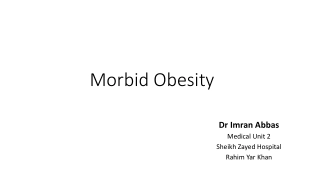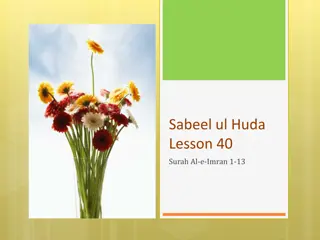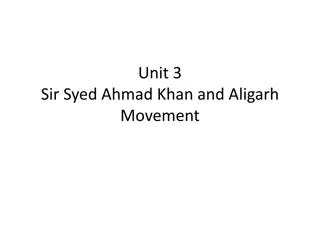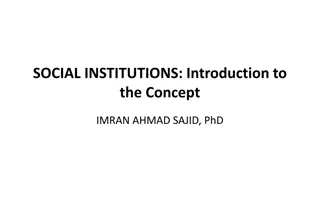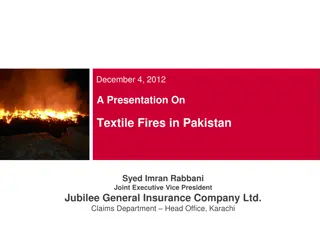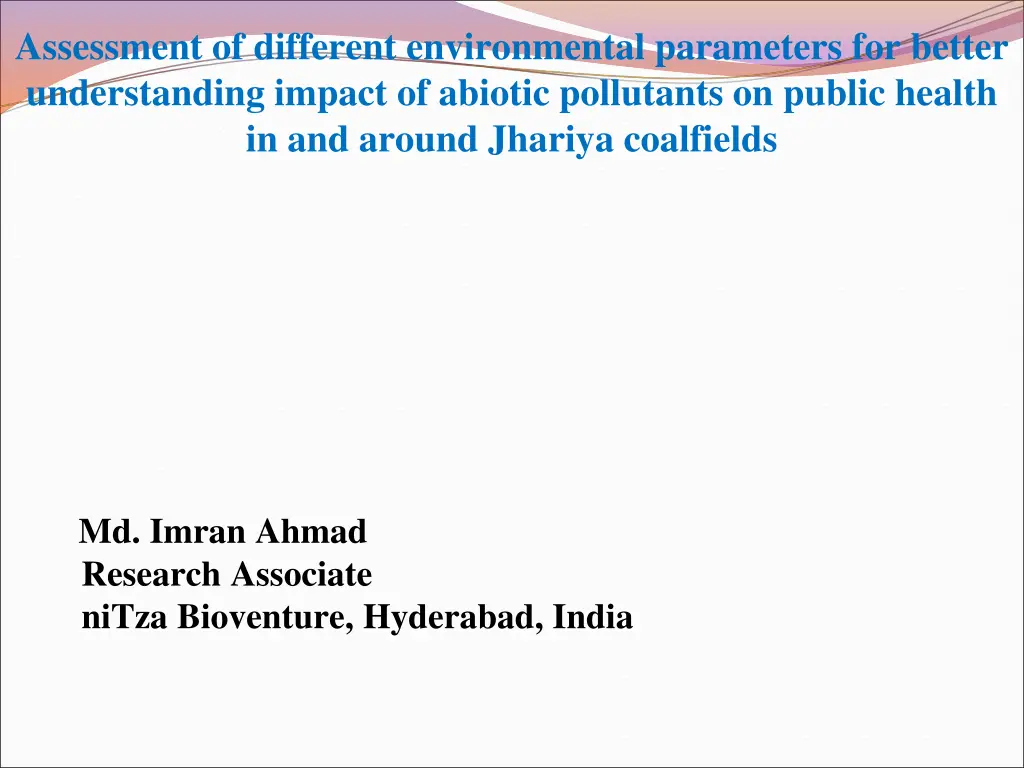
Understanding Abiotic Pollutants Impact in Jharia Coalfields
Explore the impact of abiotic pollutants on public health in and around Jharia coalfields through an assessment of environmental parameters. Discover findings on air pollution and soil quality, along with methodologies used and conclusions drawn.
Download Presentation

Please find below an Image/Link to download the presentation.
The content on the website is provided AS IS for your information and personal use only. It may not be sold, licensed, or shared on other websites without obtaining consent from the author. If you encounter any issues during the download, it is possible that the publisher has removed the file from their server.
You are allowed to download the files provided on this website for personal or commercial use, subject to the condition that they are used lawfully. All files are the property of their respective owners.
The content on the website is provided AS IS for your information and personal use only. It may not be sold, licensed, or shared on other websites without obtaining consent from the author.
E N D
Presentation Transcript
Assessment of different environmental parameters for better understanding impact of abiotic pollutants on public health in and around Jhariya coalfields Md. Imran Ahmad Research Associate niTza Bioventure, Hyderabad, India
CCONTENTONTENTS INTRODUCTION OBJECTIVES STUDY AREA METHODOLOGY RESULTS DISCUSSION CONCLUSION
Introduction Due to rapid industrialization and increase in population, there is a huge requirement of energy production to fulfill all t he necessities of the overall population. Coal is one of the major sources of energy as it is used in e lectricity generation, steel production, cement manufacturing e tc. Therefore coal production as well as coal mining has enor mously increased in India. Coal mining leads to air pollution a nd soil contamination in the local environment (Saini et al., 20 16).
Objectives To determine the air pollution status in and around Jharia coalfield Dhanbad, Jharkhand, India. To determine the soil quality in and around Jharia c oalfield Dhanbad, Jharkhand, India.
Study Area Features Dhanbad Latitude Longitude Elevation (above mean sea level) Area Population (2011 Census) 23037 3 N - 24004 N 86006 30 E - 86050 E 222 m 2,090 Km2 Total Urban Rural 1,284 26,82,662 15,59,416 11,23,246 Density (people per K m2) Mining Activities Industries Coal, Fire Clay Cement factories, Coal washeries, Refractorie s, Hard Coke Oven Plants, Beehive Coke Ove n Plants, Bricks and other miscellaneous indu stries.
Methodology Air Quality Index According to Central Pollution Control Board (CPCB), the Air Q uality Index (AQI) is an index for reporting daily air quality. It te lls us how clean or polluted air is, and what associated health effe cts might be a concern for us. AQI was calculated by the formula given by Rao and Rao (1989).
Air Quality Assessment PM2.5 - Portable Aerosol Spectrometer PM10 - Portable Aerosol Spectrometer SO2 - Portable Gas Sampler NO2 - Portable Gas Sampler
Heavy Metal Analysis Air dried sample of will be digested with HNO3and HClO4in 9: 4 ratio at 80 C until a clear transparent solution will be obtaine d (Tyler, 1974). The solution will be filtered and maintained to 25 mL with doub le distilled water. The concentrations of heavy metals in filtrate of soil samples wil l be determined with the help of Inductively coupled plasma ma ss spectrometry (ICP-MS).
Physico-chemical parameter Bulk Density Power of Hydrogen (pH) - pH meter Electrical conductivity (EC) - Electrical conductivity meter Organic Carbon (OC) - Walkley and Black, 1934 Available Nitrogen (N) - kjeldahl method Available Phosphorus - Bray s method - Gravimetric method
Results Figure: Graphical representation of Concentration of different air pollutants at (S-1) CIMFR.
Figure: Graphical representation of Concentration of different ai r pollutants at (S-2) Digwadih.
Figure: Graphical representation of Concentration of different air pollutants at (S-3) Jharia.
Figure: Graphical representation of Concentration of different air pollutants at (S-4) Chasnala.
Air Quality index (AQI) Site Months Average February March April CIMFR 74.87 86.844 77.28 79.665 Digwadih 126.365 124.96 108.9925 120.1058 Jharia 145.314 225.501 250.296 207.037 Chasnala 121.617 178.782 185.985 162.128
Figure: Graphical representation of air quality index of different site
Concentrations of heavy metals of Jharia Sl. No. 1 2 3 4 5 6 7 Heavy Metal Mn Zn Ni Cu Pb Cr Cd Concentrations (ppm) 582.645 100.665 60.985 51.755 55.16 144.41 0.42
Soil Physico-chemical properties of Jharia Sl. No. Soil properties Average Value 1 2 3 4 5 6 7 8 pH Bulk Density Electrical conductivity Water Holding Capacity Organic Carbon Available Nitrogen Available Phosphorous Available Potassium 5.515 1.324 g/cc 0.15 dS/m 58.91 % 0.069 % 72.2 kg/ha 4.24 kg/ha 353.92 kg/h
Conclusion According to AQI most unhealthy air is of Jharia and most health y is of CIMFR. It also concluded that the soil samples collected from the coal mini ng areas are poor in organic carbon, available nitrogen and availa ble phosphorus due to lower amount of microbial activities in the Jharia soil samples. Bulk densities of the soil samples are in medium range.. pH of the sampling sites is slightly acidic in nature, under these (acidic) con ditions of soils, growth of plant is affected. The soil sample at the s ampling sites was not found Soils around the Jharia coal mine were also contaminated with he avy metals. The concentrations of Mn, Zn, Cr, Ni, Cu, Pb, Cd is 582.645, 100.665, 93.625, 60.98, 51.755, 41.26 and 0.42 respectively , which deteriorates the properties of the existing soil layers in the area that s limits the ability of the soil to support vegetation. suitable for plant growth.
References Ali, H., Khan, E. &Sajad, M. A. (2013).Phytoremediation of heavy metals-concepts and applic ations. Chemosphere, 91(7), 869-881. Bera, S., Ahmad, M. &Dey, M. (2017). Satellite Image Based Study for Land Use Land Cover Changed due to Mining Activity during (1987 to 2011) at Dhanbad District of Jharkhand. Inter national Journal for Scientific & Development, 4(12), 962-965. Chaulya, S. K. (2004). Spatial and temporal variations of SPM, RPM, SO 2 and NO x concent rations in an opencast coal mining area. Journal of Environmental Monitoring, 6(2), 134-142. Goswami, S.(2015) Impact of Coal Mining on Environment: A Study of Raniganj and Jharia C oal Field in India. Mishra, N. & Das, N. (2017). Coal Mining and Local Environment: A Study in Talcher Coalfie ld of India.Air, Soil and Water Research, 10, 1178622117728913. Mondal, G. C., Singh, A. K., Singh, T. B., Singh, S., Singh, K. K. &Tewary, B. K. (2009). Ass essment of Air quality in and around west-bokaro coalfields, Hazaribagh. Indian J Environ Pro t, 29(7), 577-591. Pandey, B., Agrawal, M. & Singh, S. (2014). Assessment of air pollution around coal mining a rea: emphasizing on spatial distributions, seasonal variations and heavy metals, using cluster a nd principal component analysis.Atmospheric Pollution Research, 5(1), 79-86. Prathap, A., Kujur, V., Chakraborty, S. & Bhattacharya, T. (2016). Assessment of soil character istics in the vicinity of open cast coals mine and its suitability for vegetative reclamation in Ch arhi and Kuju of Jharkhand, India. Journal of environmental biology, 37(4), 523. Rai, A. K., Paul, B. & Singh, G. (2011). A study on physicochemical properties of overburd en dumps materials from selected coal mining areas of Jhariacoalfields, Jharkhand, Indi a. International Journal of Environmental Sciences, 1(6), 1350. Yadav, S. K., Jain, M. K., & Patel, D. K. (2018). Monitoring of Air Pollution in Different Re gions Along Road Network, Jharia Coalfield, Dhanbad, India. In Environmental Pollutio n (pp. 125-134).Springer, Singapore.
Thank You Thank You

